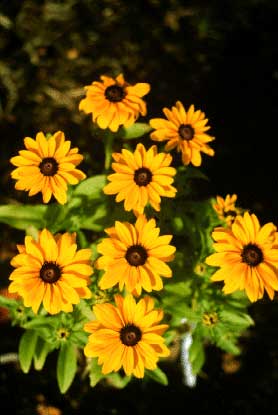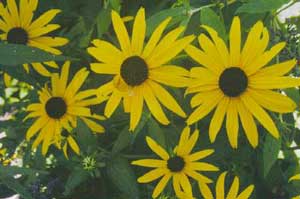 |
The jaunty daisy flowers of Black-eyed Susans are familiar to everyone as the daisies with yellow petals and brown centers. There are upwards of 30 kinds, and they are all native to the US.
Clearing Confusion - Some, like the wild ones seen in fields and along roadsides are annual plants. They and their hybrids, sometimes called Gloriosa Daisies or Coneflowers, seed themselves before they die each fall to launch new plants every spring. Others, their more domesticated cousins, are perennials, returning year after year to make excellent plants for residential yards and gardens.
Black-eyed Susans generously produce masses of yellow blooms throughout the last half of summer and well into the fall, asking very little in return. Butterflies and goldfinches find the dried bristly seedheads of black-eyed Susans irresistible. They are very low maintenance once they are established. Perennial black-eyed Susans are able to withstand winters as far north as the Great Lakes, into New York state and along the Atlantic coast up into Canada (zone 4). They will survive in any area where the temperature does not dip below -10°F or so. They also thrive in warmer regions and are found as far south as Florida. They are the Maryland state flower.
Size: Black-eyed Susans typically grow in dense, fibrous-rooted clumps on stiff stems that may grow as tall as 10 feet. However, the version that is usually offered for residential yards grows from 2 to 4 feet tall. After 3 or 4 years these clumps may spread as wide as 4 to 6 feet.
Foliage: The foliage of black-eyed Susans is quite ordinary. A medium to dark green, mature leaves are lance shaped, 3 to 6 inches long with toothed edges. They are somewhat coarse with obvious veins, as befits such a sturdy flowering plant. Some types of black-eyed susans have rough, hairy leaves.
 |
Flowers: Black-eyed Susans’ daisy type flowers typically have deep yellow ray petals surrounding dark centers. Blooms measure 2 to 2 1/2 inches across, although some types have larger ones. They appear in late July or so, blooming profusely for about 6 weeks on the tips of main stems and their subsidiary branches. Some continue to appear well into fall. By mid-October the petals have fallen and the centers have dried into prickly seed pods.

